Metro
Manila Air Quality:
Killing You Softly
By
Marian C. Martin
Photos by Manny
Fernandez
|
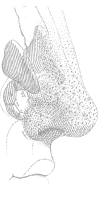 |
Breathing is a sign of life. But in Metro Manila, it can cause
death. The air that we breathe can now also kill us. Metro Manila
residents have long bemoaned the blanket of dust, soot and dangerous
gases that hangs ominously over the city.
The Asian Development Bank financed a study called the Metro Manila
Air Quality Improvement Sector Development Project in 1998 to study
the city’s pollution problem. The aim of the program is to improve
the air quality in the Metro Manila air shed. The study harnessed
the combined efforts of the Department of Environment and Natural
Resources, Health, Public Works and Highways, Transportation and
Communications and the Metro Manila Development Authority. The study
conducted a comprehensive baseline research study to determine the
effects of pollution to the health of the residents.
|
|
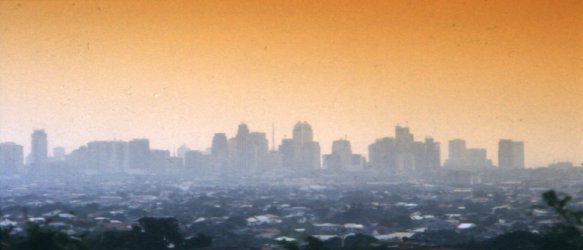 |
| A pall of soot-laden air chokes Metro Manila. |
|
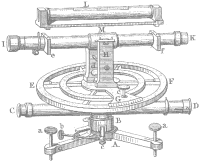 |
 o
keep tabs on air quality in Metro Manila, Cesar Siador Jr., Chief of
Air Quality Management of the DENR, says that the DENR deployed nine
monitoring stations and six automatic monitoring stations at
strategic areas. These monitor the levels of concentration of six
major pollutants. Air samples are taken every eight hours and
brought to the DENR laboratory in Quezon City for analysis. “The
nine manual stations monitor sulfur dioxide and particulate matter
(PM10). The automatic stations monitor sulfur dioxide,
oxides of nitrogen, photochemical oxides like ozone, carbon monoxide
and lead.” The DENR follows guidelines established by the World
Health Organization that specify what levels of pollutants are
acceptable. o
keep tabs on air quality in Metro Manila, Cesar Siador Jr., Chief of
Air Quality Management of the DENR, says that the DENR deployed nine
monitoring stations and six automatic monitoring stations at
strategic areas. These monitor the levels of concentration of six
major pollutants. Air samples are taken every eight hours and
brought to the DENR laboratory in Quezon City for analysis. “The
nine manual stations monitor sulfur dioxide and particulate matter
(PM10). The automatic stations monitor sulfur dioxide,
oxides of nitrogen, photochemical oxides like ozone, carbon monoxide
and lead.” The DENR follows guidelines established by the World
Health Organization that specify what levels of pollutants are
acceptable.
Surprisingly,
Siador reveals that the pollution picture isn’t as bad as people
would think. “For the gaseous pollutants, we are within the
guideline values of the WHO. We are more polluted than other cities
in only one parameter: particulate matter. Particulate matter is the
minute matter that floats in the air.” He points out that even the
high concentration of PM10 is still within acceptable limits over a
24-hour period. The highest it has ever reached is 213.55
micrograms/normal cubic meter. The safe level is 230 micrograms/NCM. |
|
 iador discloses that the pollution in Metro Manila
is worst in the north, particularly in Valenzuela, Bulacan. The air
quality improves significantly the farther south one goes. By the
time you get to Sucat, Parañaque, he notes, the air quality is
already fair. Over the year, air pollution is worst during the dry
season. “We are happy when it rains because it naturally cleans
the environment. But in some areas, like EDSA, where traffic is
heavy year-round, we have high concentrations of PM10
even during the rainy season.” He says that during the day,
pollution peaks between 6 a.m. and 10 a.m. and again between 1 p.m.
and 7 p.m. Another peak period follows in the evening, between 10
p.m. and midnight. iador discloses that the pollution in Metro Manila
is worst in the north, particularly in Valenzuela, Bulacan. The air
quality improves significantly the farther south one goes. By the
time you get to Sucat, Parañaque, he notes, the air quality is
already fair. Over the year, air pollution is worst during the dry
season. “We are happy when it rains because it naturally cleans
the environment. But in some areas, like EDSA, where traffic is
heavy year-round, we have high concentrations of PM10
even during the rainy season.” He says that during the day,
pollution peaks between 6 a.m. and 10 a.m. and again between 1 p.m.
and 7 p.m. Another peak period follows in the evening, between 10
p.m. and midnight.
The DENR has
used its monitoring-stations data to issue periodic warnings to the
public or to aid legislation. Siador notes that on the strength of
the DENR’s recommendation, the government banned open fires and
the burning of rubber tires in Metro Manila. He recalls that data
collected by the DENR in 1993 and 1994 on the levels of lead in the
atmosphere led to a campaign to reduce lead emissions. The result
was the Clean Air Act which, among other things, obligated industry,
civil society and the government to reduce the lead content in
gasoline and to start making available unleaded gasoline. He reports
that by February 1994, lead concentration in the air plunged to 1.29
micrograms/NCM. It has been falling every year since then. In 2000,
lead went down to .04 microgram/NCM. “We can now say that Metro
Manila is lead-free. In January this year, the lead content went
down to as low as .01 microgram/NCM in some parts of Metro
Manila.”
|

|
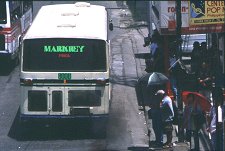 |
Diesel engines may have beaten the rap on lead poisoning but they're guilty
of a whole plague of pulmonary diseases. |
|
|
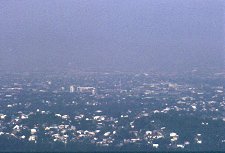 |
| Heavy air pollution is a major cause of pulmonary ailments in the metropolis. |
|
|
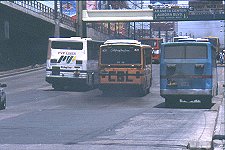 |
| Buses with old, poorly maintained diesel engines are the heaviest polluters. |
|
 r. Desiree Narvaez, Chief of the Environmental and
Occupational Health Office of the DOH believes that the public
should remain alert to the impact of pollution on health. She says
that the DOH made a baseline health profile under the Metro Manila
Air Quality Improvement Sector Development Project involving several
barangays in Metro Manila. She warns of incidences of respiratory
diseases like asthma, bronchitis, coughs, colds and chromic
obstructive pulmonary disease. The study says there’s a rise in
morbidity rates in Malolos, Bulacan and Navotas which could be
attributed to air pollution there. r. Desiree Narvaez, Chief of the Environmental and
Occupational Health Office of the DOH believes that the public
should remain alert to the impact of pollution on health. She says
that the DOH made a baseline health profile under the Metro Manila
Air Quality Improvement Sector Development Project involving several
barangays in Metro Manila. She warns of incidences of respiratory
diseases like asthma, bronchitis, coughs, colds and chromic
obstructive pulmonary disease. The study says there’s a rise in
morbidity rates in Malolos, Bulacan and Navotas which could be
attributed to air pollution there.
The study
indicates that the average hourly levels of PM10 are
indicative of unhealthy conditions for children, the elderly and
those already suffering from asthma and respiratory diseases. The
study states “exposure to lead indoors is still important
considering that lead levels are measured in three-fourths of the
study households. This exposure partly contributed to the blood
levels determined among the study children.” The study also
mentions the levels of benzene indoors. The study states
“Available data indicate that a significant proportion of six- to
ten-year-old children in the study households exceeded the WHO
recommended limit for children which is 20 micrograms/dl.”
Dr. Narvaez says a high level of lead in the blood can affect the
development of the children’s central nervous system (CNS) and
their cognitive functions, perhaps even decrease their IQs. It can
also give rise to behavioral problems. “Bad” ozone damages lung
tissue. Sulfur dioxide aggravates existing respiratory and
cardiovascular disease. Carbon monoxide reduces the capacity of
blood to transport oxygen from the lungs to the different tissues.
Nitrogen dioxide irritates the lungs and lowers resistance to
respiratory infections. PM10 aggravates existing heart
and lung disease. Hydrocarbons, such as benzene, affect the blood
and the CNS, causing dizziness or headaches. More disturbing, they
also depress the immune system.
|
|
 r. Narvaez
says residents can protect themselves in a number of ways: by
installing air-conditioning in their homes, for instance, or by
wearing masks if they are passing through heavily polluted areas.
“People can avoid smoking indoors. When you are indoors you can
close the windows if you live in a polluted area or just have a
little ventilation at night.” r. Narvaez
says residents can protect themselves in a number of ways: by
installing air-conditioning in their homes, for instance, or by
wearing masks if they are passing through heavily polluted areas.
“People can avoid smoking indoors. When you are indoors you can
close the windows if you live in a polluted area or just have a
little ventilation at night.”
But
pollution, it seems, can only be reduced by a major effort by the
government and the public. Siador says the Clean Air Act has been
implemented and he hopes it will reduce pollution in Metro Manila.
The general public, however, will do well to prod the government to
adopt a more aggressive stance towards the quest for cleaner air.
|
 |
| |
|
|
|
|
|







